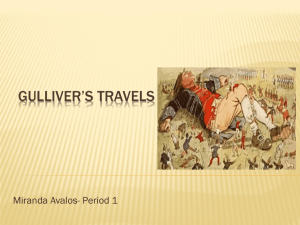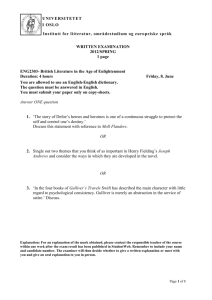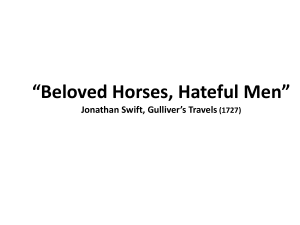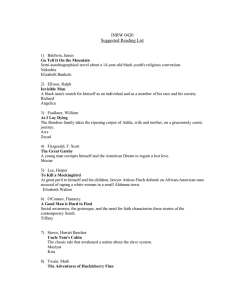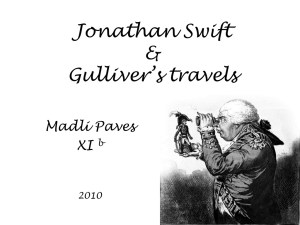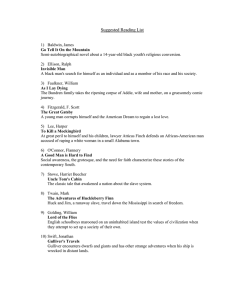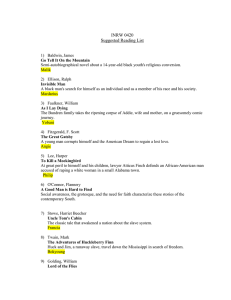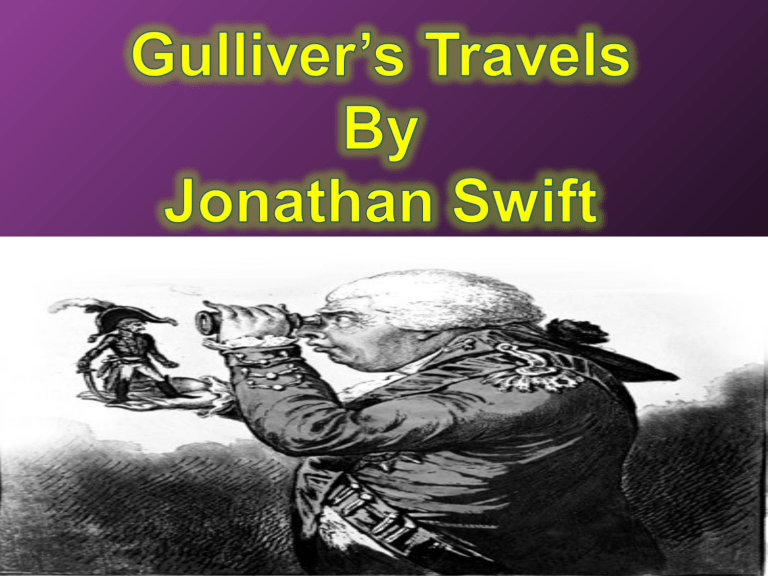
• Born in Dublin, Ireland -Posthumous Child • Father died, mother left • suffered from poverty • Education Kilkenny Grammar School • 1682-86 Trinity College in Dublin • 1689 went to England : Hoped to gain preferment in the Anglican Church worked for Sir William Temple met Esther Johnson – “Stella” • began to suffer from Meniere’s Disease • got a M.A. degree from Oxford Satires: Other: A Tale of a Tub The Journal to Stella The Battle of the Books Also wrote many sermons, prayers, etc. A Modest Proposal A Meditation Upon a Broom-Stick Gulliver’s travels Pamphlets: The Abolishing of the Christianity in England On the conduct of the allies The Barrier Treaty The Public Spirit of the Whigs Poems: A Beautiful Young Nymph Going to Bed Cadenus and Vanessa A Description of a City Shower Part 1 – A Voyage to Lilliput Part 2 – A Voyage to Brobdingnag Part 3 – A Voyage to Laputa, Balnibarbi, Glubbdubdrib, Luggnagg, and Japan Part 4 – A Voyage to the Country of the Houyhnhnms Gulliver's Travels is the story of Lemuel Gulliver and his voyages around the world. Prefaced by two letters attesting to the truth of the tales, the adventures are told by Gulliver after his return home from his final journey. • Gulliver’s Travels, Jonathan’s best fictional work, was published in 1726, under the title of Travels into Several Remote Nations of the World, by Samuel Gulliver. The book contains four parts, each dealing with one particular voyage during which Gulliver meets with extraordinary adventures on some remote island after he has met with shipwreck of piracy of some other misfortune. Part 2 Part 3 Part 1 Part 4 • The third part deals with mainly with his accidental visit to the flying Island, where the philosophers and projectors devote all their time and energy to the study of some absurd problems. Their scientists are engaged in projects for exacting sunbeams out of cucumbers, turning ice into gunpowder and making cloth from cobweb. It is a parody on scholastics and projectors. The part that we are focusing on is ….. • The last part is a most interesting account of his discoveries in the Houyhnhnm land, where horses are endowed with reason and all good and admirable qualities, and are the governing class. • Contrary to the Houyhnhnms, the Yahoos possess every conceivable evil. They are malicious, spiteful, envious, unclean and greedy. Gulliver admires the life and ways of the horses, as much as he is disgusted with the Yahoos, whose relations remind him of those existing in English society to such a degree that he shudders at the prospect of returning to his native. • Part four: Gulliver is most affected by his final journey. He loves the houyhnhnms and wishes to stay with them, but he cannot. • Houyhnhnms are a race of intelligent horses described in book four of Gulliver’s Travels • Contrasts against the Yahoos who are savage creatures, and represent all that is bad of the human race The Houyhnhnms are clever, peaceful and trustworthy. But they are passionless and dull. In the end human beings are somewhere between Houyhnhnms and Yahoos. The Houyhnhnms share their country with a race of wild, stupid, filthy creatures called Yahoos. To The Houyhnhnms Gulliver looks like a Yahoo. When Gulliver returns to England at the end of the book, he cannot bear to be around people or look in the mirror, he is so horrified by the human race. • Gulliver describes them to be very savage-like, ugly, and unpleasant. • They live in servile to the Houyhnhnms. • They are beasts that look like humans. • Gulliver describes them to be very savage-like, ugly, and unpleasant • Gulliver despises the Yahoos. He hates that the Houyhnhnms mistake him as a Yahoo because they are similar in some ways • At the end, Gulliver finally comes to realize that he is actually a lot like the Yahoos By the end of the book, Gulliver has basically been driven mad. He cannot bear to look at his wife and family. He buys some horses and spends his time talking to them.
